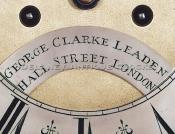George Clarke of Leaden Hall Street London, England. Tall case clock. 214021.
A fine and substantial walnut veneered case tall clock with break arch bonnet and composite brass dial signed by the Maker, “George Clarke Leaden / Hall Street London.”
George Clarke is listed in Brain Loomes’ “Watchmakers & Clockmakers of the World” as working from 1725 until he died in 1766. He is a well-known clockmaker, and examples of his work are shown in several museums and collections around the world. He is known for his clocks with Turkish numerals and supplied many to the wealthy of Constantinople and the Ottoman Empire. Tall case clocks, musical clocks, and lantern clocks have survived.
This cabinet exhibits wonderful walnut wood selections throughout its construction. This includes the wood used on the sides of the case as well. The base is supported on a double-stepped molding that rests flat on the floor. The waist is long and narrow. It is fitted with a tombstone-shaped waist door trimmed with applied molding. The veneer selected for this location is outstanding. The grain pattern has been well-planned and is centered in this prime visual location. The bonnet is a break arch form. Turned bonnet columns are applied to the bonnet door. These terminate in brass capitals. The columns visually support the arch moldings. An intricate pattern of blind fretwork has been incorporated into the hood design above the arched molding. These moldings are wonderfully formed and feature good-quality wood. Above the blind fret section is a caddy top. Three brass ball and spike finials are mounted on plinths. The bonnet door opens to access the dial.
This brass dial predates the painted dial. This was a very expensive dial to manufacture. It is constructed with a solid sheet of brass decorated with applied cast brass spandrels, a chapter ring, and decorative engravings. The spandrels are a popular form and are cast in yellow brass. Each of the four corner spandrels features a female head and headdress centered amongst swirling foliage. The arch spandrels display a floral theme. These center a month calendar ring. Arabic figures include 5,10, 15, 20. 25, and 31. An interior ring is divided into 31 increments. Inside this is a very interesting engraving that features a bird or two. Located at the bottom of this ring applied is a “Strike / Silent” switch. This allows one to manually turn on or off the clock's striking train. The time ring displays the five-minute makers in Arabic figures. The Hours are indicated in large Roman numerals. This chapter ring features two-minute rings. The interior minute ring is an early feature and falls out of favor by the 1750’s. Please also note the use of the decorative flier-de-lis in between the Roman hours. A subsidiary seconds dial is located in the traditional location. Interestingly, it features Arabic figures at five-minute intervals. The Clockmaker signs this dial on the time ring between 4:30 and 7:30. This signature and working location are written in a block letter format. The middle section of the dial is matted. This treatment aided one in locating the hands while reading the dial. A brass dial in the 1700s could quickly tarnish in rooms heated by coal and lit by candle or oil light. This could make it somewhat difficult to read in a poorly lit room. This clock was made and used long before the discovery and use of electricity. Today, dials like this keep their contrasting for generations because the environment is so much cleaner. The steel hands are wonderfully made.
The movement is constructed in brass, with nicely finished cast brass plates supported by ring-turned brass posts. The gearing is brass, and the pinions are hardened steel. This mechanism is weight-driven and designed to run for eight days fully wound. The winding barrels grooved. This clock strikes each hour on a bell mounted above the plates. The strike train is located between the plates and is actuated by a rack and snail design. A seaboard supports the movement. The pendulum features a metal rod and a brass-faced lead bob.
This clock stands an impressive 8 feet 11 inches tall to the top of the center brass finial. It was made circa 1740.
English clocks of this quality are very difficult to find in today’s market.
Inventory number 214021










